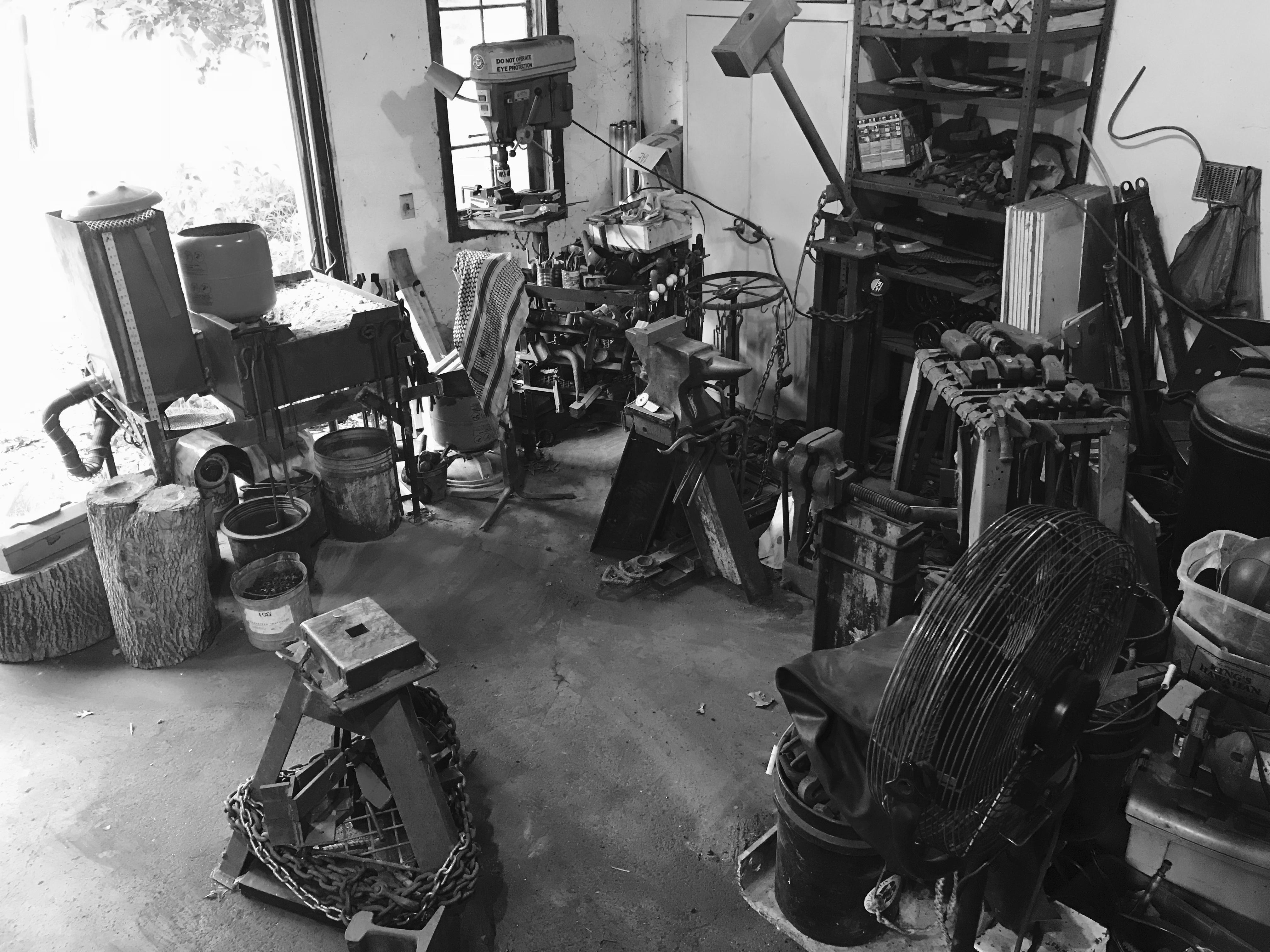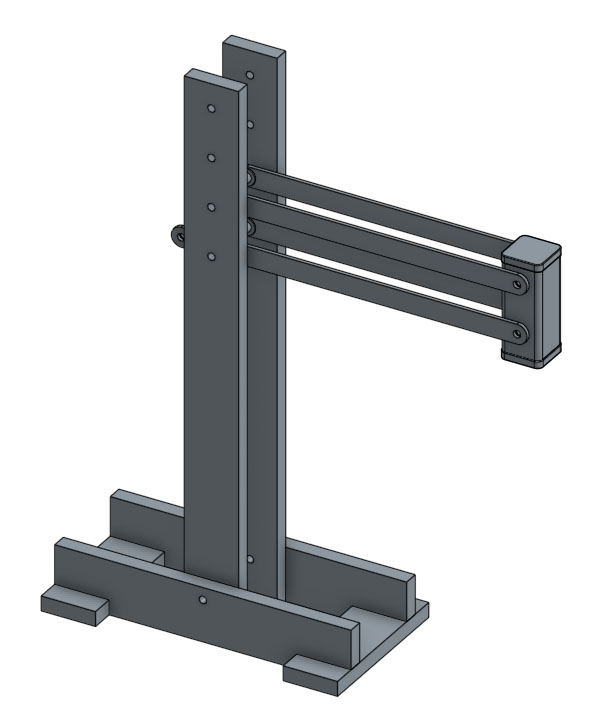-
Posts
19,312 -
Joined
-
Last visited
Content Type
Profiles
Forums
Articles
Gallery
Downloads
Events
Everything posted by JHCC
-
Weld them up into a 24" square checkerboard (high-and-low instead of black-and-white) and then forge a set of chess pieces. No, wait -- you only have 20 of each, and you'd need 32 (64 total). Are you sure they don't have more?
-
Try this: instead of forging the threaded rod to round, forge it into an octagon and then give it a twist. This will create a faceted spiral effect, which looks a lot like scales. Then forge the curves into the snake with a heavy wooden mallet, to minimize damage to the pattern. The simplest way to control airflow would be to take the flex pipe out of the black iron and aim it so that some of the airflow goes past the black iron rather than in. By changing the amount that gets spilled outside your tuyere, you can regulate the volume of the blast. Oh, and if your forgings look good (and you're not inviting prospective customers into the forge), it doesn't matter what your setup looks like, so long as it's functional and safe.
-

Need help identifying anvil
JHCC replied to Holly Schwartz's topic in Anvils, Swage Blocks, and Mandrels
FYI, there's no version of the "Yankees destroying Confederate anvils" story in Bealer's The Art of Blacksmithing, and it's very much the kind of thing that he would have repeated (perhaps uncritically) if he'd heard it. I suspect that if it had been circulating when he wrote TAoB in the late Sixties, it would probably be in there. (And yes, I know that absence of evidence is not evidence of absence, but it does add weight to the "improbable" side of the scale.) -
Okay, that's more than a stress crack! Weird!
-
@patrick, thank you very much for an informed and thorough answer both to the original question and to the issues raised in the subsequent discussion. This raises an interesting (if largely academic question) about the strength of pattern-welded blades, especially those mosaic damascus blades where the billets are cut, rotated, stacked, welded, lathered, rinsed, and repeated for visual effect.
- 32 replies
-
- heat treating
- forging carbon steel
-
(and 1 more)
Tagged with:
-
Sorry, my hair is no longer sufficiently fabulous.
-

Need help identifying anvil
JHCC replied to Holly Schwartz's topic in Anvils, Swage Blocks, and Mandrels
George, it would be great if you could provide a citation or a title of one of those books, so the rest of us could check it out for ourselves. Thanks much. -
Probably an old stress crack that finally let go. There was a post a few days ago about someone's well-used punch that split apart after years of use, probably for the same reason.
-
Oh, you can tell by the way I swing my sledge, I'm a smithin' man -- no need to hedge. Fire's hot and flames are fast, Each nail is better than the last. But it's all right, it's okay, I'll do it @ThomasPowers's way. I can try to understand, How to rewire a blower fan. Whether you're a blacksmith or whether you're a bladesmith, You're smithin' all night, smithin' all nigh. Hear the anvil ringing and see the LG swinging, You're smithin' all night, smithin' all night. Bang! Bang! Bang! Bang! Smithin' all night, smithin' all night! Bang! Bang! Bang! Bang! Smithin' all night, smithin' all night!
-

What did you do in the shop today?
JHCC replied to Mark Ling's topic in Blacksmithing, General Discussion
I'm a few hundred miles from my shop, so I've been working (first in my head, then on screen) on an (as-yet unfinished) idea for a treadle hammer. Hey, @littleblacksmith! Nice work, and a great collection of pieces. One little detail: you might want to put a bit of a point on the bottoms of the hearts, just to sharpen them up a bit. There are two methods I'd recommend: Lee Sauder's and Rowan Taylor's. They're both really simple, and would be easily adapted to what you're doing here. Just a suggestion. -
@gote is right, though; there is another thread somewhere where @ThomasPowers describes the technique more explicitly. I can't find it either.
-
https://www.iforgeiron.com/topic/3602-thomas-powers-applied-anvil-acquisition-technique/
-
I've got a bunch of five-gallon buckets with a couple of general categories of different kinds of scrap.
-
I'm going to guess that this was the base for something, the rest of which is now missing.
-
May I commend to your attention the pallet wood gate valve.
-
All good points. Same here. Don't give him ideas!
-
Weld on 2"-3" floor flanges and screw in matching drain plugs?
-
Drill and tap for two oil pan drain plugs: one at the top of the one side of the tube, and one near the bottom. You can adjust the weight of the stand by adding sand through the top hole (with a funnel, probably) and removing it from the bottom hole as needed. Greater overall mass will help your anvil and stand resist any hammering forces that aren't straight down, and lowering the center of gravity will make the whole thing less tippy.
-
Is that just the pan on top that's filled with sand, or the whole thing?
-
The only things that truly offend us are people being unwilling to learn or promoting practices that are patently unsafe. You're doing fine.
-
Hello, Loki Smith! Welcome to IForgeIron. First of all, thank you for putting your location in your profile settings. We have a number of Australian members, and you may be able to connect with them for information about what tooling is available near you. We have many, many threads here on IFI about how to get started, what you need at a bare minimum, what to look for, and so on. Rather than repeating all of that, I strongly suggest that you budget a big chunk of time to read over the forum as exhaustively as you can, looking in particular for threads on getting started, building a simple forge, makeshift anvils, and the like. You will learn a lot, and you'll be able to ask much better-informed questions. For now, just let me say that you can forge with a claw hammer, but it's not a great idea. If you're planning on getting something from the hardware store, look for what's called a "drilling hammer". Again, this has been discussed already at length, so take a look for those conversations as well. Best of luck!
-
I wouldn't answer the milk question the same way because (A) the retail price of milk is a commonly used benchmark for the cost of living and (B) milk is a widely available commodity with minimal variation in quality. Your assumption about what the OP means is not unreasonable, but there's it's precisely because we're talking about antiques (a market with great volatility and little consistency, where condition is everything) that those additional details are necessary for any kind of reasonably accurate reply.
-
Your desired finish -- or any other -- can be achieved by either machine or hand work. There is no intrinsic mystical quality to handmade exclusively. For your own work, use as much or as little machinery as you like. If part of your goal is to derive satisfaction from working exclusively by hand, go for it. If you find you can work more efficiently and effectively by incorporating machines, go for it. I'm a hobbyist, too. My blower is mechanical, I use electric drills and angle grinder, and I would love to have a power hammer. I used to be a 100%-hand-work-or-nothing guy, but that was a looooong time ago.
-
(I should note that the fan as positioned in the picture is in its "blow away the smoke from kindling the forge fire" configuration; when the fire is up and running, I move the fan a few feet to the right, to cool me off without blowing right over the JABOD.)
-
Hard to tell from the photos, but it looks like the face could be significantly damaged. That would certainly give me pause. You don't have your location in your profile (you can add it in the settings), so it's hard to tell whether or not you live in an anvil-rich area. If you're in Antarctica, I would imagine that any anvil at all would be worth the drive.

